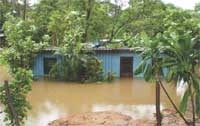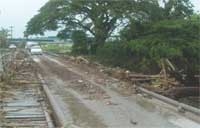Extreme rainfall and new records in the Fiji Islands, January 2009


Fiji Meteorological Service
January 2009 was the wettest first month of the year in more than a century at several locations in Fiji. The total monthly rainfall was equivalent to or above 200% of normal at more than 75% of reporting stations in the Western, Central and Eastern Divisions of the country. Fourteen monthly rainfall totals and seven 24hr daily rainfall records were broken during the month. The considerable amount of rainfall was due to a number of intense synoptic scale weather features that impacted the Fiji region, including an active monsoonal trough, an enhanced South Pacific Convergence Zone (SPCZ), two Tropical Depressions, and Tropical Cyclone (TC) Hettie.
The hovering of the monsoonal trough and SPCZ over Fiji during the early to middle part of January resulted in severe flooding that claimed 12 lives and caused major damage in many parts of Viti Levu and Vanua Levu. Many roads and bridges including the Sigatoka old bridge were destroyed. There was significant damage to agricultural crops along the major floodplains. Ba, Nadi, and parts of Sigatoka town were flooded. In the case of Ba and Nadi, flooding was the worst in over 75 years. School facilities and homes in these areas were without water and electricity for several days due to broken water pipes. As of 30 January, the flood related damage cost is F$76.1M.
The January 2009 floods are the worst natural disaster ‘economically’ to affect Viti Levu since the drought of 1998. The title of ‘worst natural disaster’ should probably continue to apply to the TC(s) and flooding in late February 1931 when flooding similar in magnitude to the 2009 event (but including the Rewa River) claimed more than 200 lives. There were statements in the media soon after the recent flood that the 2009 event was higher than the 1931, 8.37 m above mean sea level record at the Rarawai Mill.
Highlights of the month include:
- Seven sites receiving more than 200 mm rainfall in 24 hours
- A daily rainfall total of 378 mm on the 13th at Nabouwalu, breaking the record from 1932
- Fourteen stations recording more than 700 mm rainfall
- Seven sites receiving more than 1m of rainfall
- A total monthly rainfall of 1545.1 mm recorded at Monasvu, the highest since records began there in 1980
A complete accounting of the month’s events, climate statistics, an explanation of the cause of the January flooding, and photographs from across Fiji of the flood damage can be found on the Fiji Meteorological Services website (www.met.gov.fj/).
Further enquiries about the floods can also be directed to the Fiji Meteorological Services by emailing [email protected].
